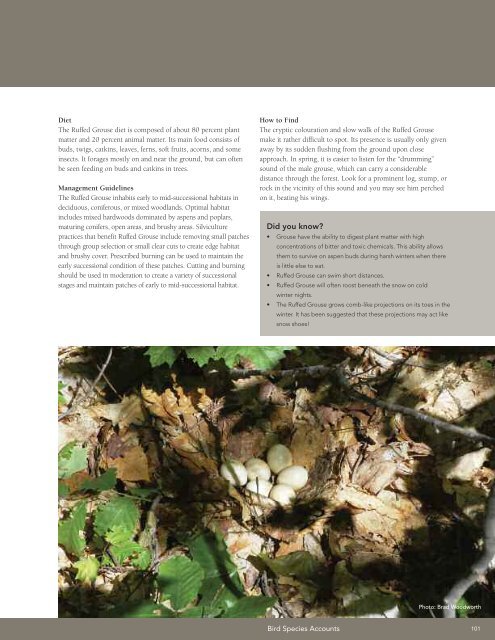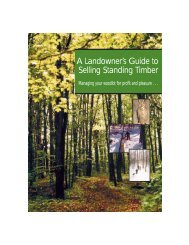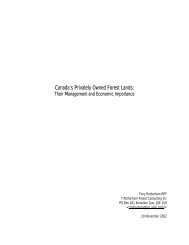A land manager's guide to conserving habitat for forest birds in ...
A land manager's guide to conserving habitat for forest birds in ...
A land manager's guide to conserving habitat for forest birds in ...
You also want an ePaper? Increase the reach of your titles
YUMPU automatically turns print PDFs into web optimized ePapers that Google loves.
Diet<br />
The Ruffed Grouse diet is composed of about 80 percent plant<br />
matter and 20 percent animal matter. Its ma<strong>in</strong> food consists of<br />
buds, twigs, catk<strong>in</strong>s, leaves, ferns, soft fruits, acorns, and some<br />
<strong>in</strong>sects. It <strong>for</strong>ages mostly on and near the ground, but can often<br />
be seen feed<strong>in</strong>g on buds and catk<strong>in</strong>s <strong>in</strong> trees.<br />
Management Guidel<strong>in</strong>es<br />
The Ruffed Grouse <strong>in</strong>habits early <strong>to</strong> mid-successional <strong>habitat</strong>s <strong>in</strong><br />
deciduous, coniferous, or mixed wood<strong>land</strong>s. Optimal <strong>habitat</strong><br />
<strong>in</strong>cludes mixed hardwoods dom<strong>in</strong>ated by aspens and poplars,<br />
matur<strong>in</strong>g conifers, open areas, and brushy areas. Silviculture<br />
practices that benefit Ruffed Grouse <strong>in</strong>clude remov<strong>in</strong>g small patches<br />
through group selection or small clear cuts <strong>to</strong> create edge <strong>habitat</strong><br />
and brushy cover. Prescribed burn<strong>in</strong>g can be used <strong>to</strong> ma<strong>in</strong>ta<strong>in</strong> the<br />
early successional condition of these patches. Cutt<strong>in</strong>g and burn<strong>in</strong>g<br />
should be used <strong>in</strong> moderation <strong>to</strong> create a variety of successional<br />
stages and ma<strong>in</strong>ta<strong>in</strong> patches of early <strong>to</strong> mid-successional <strong>habitat</strong>.<br />
How <strong>to</strong> F<strong>in</strong>d<br />
The cryptic colouration and slow walk of the Ruffed Grouse<br />
make it rather difficult <strong>to</strong> spot. Its presence is usually only given<br />
away by its sudden flush<strong>in</strong>g from the ground upon close<br />
approach. In spr<strong>in</strong>g, it is easier <strong>to</strong> listen <strong>for</strong> the “drumm<strong>in</strong>g”<br />
sound of the male grouse, which can carry a considerable<br />
distance through the <strong>for</strong>est. Look <strong>for</strong> a prom<strong>in</strong>ent log, stump, or<br />
rock <strong>in</strong> the vic<strong>in</strong>ity of this sound and you may see him perched<br />
on it, beat<strong>in</strong>g his w<strong>in</strong>gs.<br />
Did you know?<br />
• Grouse have the ability <strong>to</strong> digest plant matter with high<br />
concentrations of bitter and <strong>to</strong>xic chemicals. This ability allows<br />
them <strong>to</strong> survive on aspen buds dur<strong>in</strong>g harsh w<strong>in</strong>ters when there<br />
is little else <strong>to</strong> eat.<br />
• Ruffed Grouse can swim short distances.<br />
• Ruffed Grouse will often roost beneath the snow on cold<br />
w<strong>in</strong>ter nights.<br />
• The Ruffed Grouse grows comb-like projections on its <strong>to</strong>es <strong>in</strong> the<br />
w<strong>in</strong>ter. It has been suggested that these projections may act like<br />
snow shoes!<br />
Pho<strong>to</strong>: Brad Woodworth<br />
Bird Species Accounts 101

















